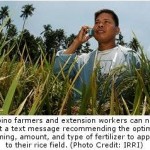 In March 2012, Global Reporting Initiative (GRI) launched its XBRL Taxonomy – an open-source tagging language similar to XML, used for tagging data in reports. XBRL stands for eXtensible Business Reporting Language, and the Taxonomy, which covers the G3 and G3.1 Guidelines, enables users to tag and identify individual detailed reporting elements which can be easily shared electronically.
In March 2012, Global Reporting Initiative (GRI) launched its XBRL Taxonomy – an open-source tagging language similar to XML, used for tagging data in reports. XBRL stands for eXtensible Business Reporting Language, and the Taxonomy, which covers the G3 and G3.1 Guidelines, enables users to tag and identify individual detailed reporting elements which can be easily shared electronically.
GRI’s Taxonomy is one of the first XBRL taxonomies for sustainability reporting and was produced in collaboration with Deloitte Netherlands. In September, Deloitte published its 2011/2012 sustainability report, which was produced as both a traditional report and as an XBRL instance file using GRI’s Taxonomy.
Deloitte Netherlands’ Sustainability Manager, Mark van Rijn, says there were three main reasons why Deloitte used the GRI Taxonomy in its reporting cycle, “Firstly, because we see it as the way forward in sustainability reporting. It offers advantages that traditional sustainability reporting doesn’t – it facilitates data comparability, and will be a tremendous asset in the future for stakeholders if the GRI Taxonomy is used widely.”
“Secondly, we felt that it provides an opportunity to link up our reports. In the GRI Reference Table of our traditional sustainability report, we reference other documents, such as the Annual Report. By using XBRL, we can include the actual data rather than just a reference. This means stakeholders can be presented with all the information they need in one document – the XBRL instance file. For transparency reasons, this is a great way forward.”
“Finally, if you look at the kind of information companies need to publish – taking into account the new integrated reporting developments – we should ideally be seeing high-level, short reports with solid data underpinning them. XBRL fits this picture.”
The GRI Taxonomy is suitable for any organization that wants greater reliability and consistency of sustainability performance information. It also enables faster data collection, aggregation and sorting analysis, and increases the ability to customize reporting to meet the specific needs of information users.
Ernst & Young Netherlands also recently published its 2011/2012 Integrated Annual Report using GRI’s XBRL Taxonomy. “This is the first time Ernst and Young has produced an integrated report,” says Nancy Kamp-Roelands, Integrated Reporting Leader at Ernst & Young, Netherlands, who worked together with Ernst & Young’s XBRL expert, Huub Lucassen.
“We took the decision to make our integrated report available in XBRL format as we found that the GRI Taxonomy includes many elements that are closely aligned with integrated reporting, and applying the Taxonomy refined the way we report on our key performance indicators. We expect that XBRL will be increasingly used for disclosure on sustainability information and will facilitate and improve the comparability of information.”
XBRL can also positively impact completeness and accuracy. “If you use the Taxonomy, you really have to drill down into the Indicators and disclosure items,” says van Rijn. “This process of using the Taxonomy resulted in some changes to our sustainability report itself. We found that in a few cases we were not expressing ourselves in depth, or that our metrics were not in line with the Indicators. By using XBRL, we were able to make sure that the claims we were making in our sustainability report were justified.”
XBRL is a fairly new idea in the sustainability reporting field, of course, and as such it has not been used by many reporters. This can be something of a challenge, explains van Rijn, “Doing it knowing that at this point in time XBRL instance files for sustainability reports are not used broadly can be quite a challenge. Making something that is not commonly used means you have to persuade a lot of people within the company to do it – we developed strong arguments about why we think it’s the future.”
“Another challenge was keeping everything in sync – we had to track the changes we made in the sustainability report to make sure the data matched what was in the XBRL instance file.”
Despite these challenges, van Rijn recommends using XBRL for sustainability reporting, “Absolutely do it,” he says. “The GRI Taxonomy gives you an insight that you don’t get with conventional reporting. Many companies are using the Guidelines and claiming they fully report things. Using the GRI Taxonomy is a good way to check claims – to check for yourself to what depth you are covering the intellectual capital of GRI.”
“Also, for the sake of keeping reporting communicative, all companies should use XBRL – that way the instance file contains all the nitty-gritty data and the report itself can tell the story. Finally, the more companies use XBRL, the more useful it will be to stakeholders. Financial stakeholders in particular use a lot of data and using XBRL facilitates their work, while also reducing the burden of completing many different questionnaires.”
Kamp-Roelands echoes van Rijn’s thoughts, saying, “XBRL improves the availability of comparable information enormously. For companies that are already reporting on sustainability information according to the GRI Guidelines, the use of XBRL is a logical next step. It facilitates investors, business partners, customers and other stakeholders that wish to compare performance. The initial investment that goes into mapping information to the XBRL format may seem a challenge, but the long term benefits will be seen for years to come. As with every new development, however, we need to see a sharing of experiences. The more companies start reporting with XBRL, the easier it will be to actually compare sustainability information.”
GRI’s XBRL Taxonomy will continue to be developed and in due course be aligned with GRI’s next generation of Guidelines – G4. Further development will also depend on the extent to which the Taxonomy is used and the needs of users. Any organization can now download and use the XBRL Taxonomy.
Source: GRI.












